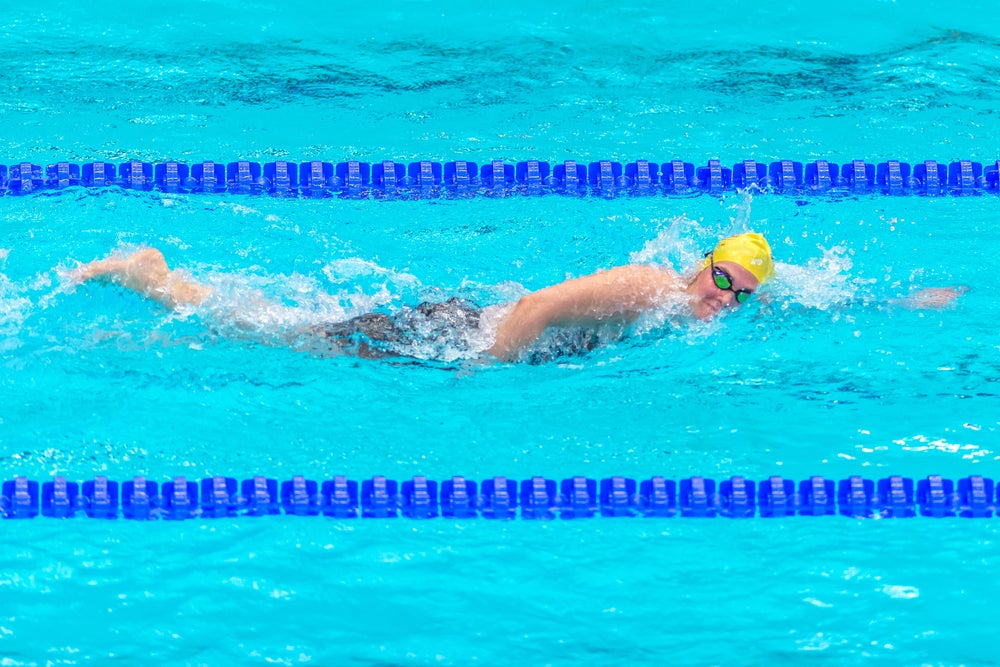Indoor Triathlon 101: Distances, Training, Gear, and Everything Else to Know

The indoor branch of the sport has grown significantly in the past decade, thanks to indoor tri series from USA Triathlon and Life Time Fitness. Local pools and gyms are getting in on the action, too, offering indoor triathlon races that appeal to beginners and seasoned athletes alike.
Unlike a traditional triathlon, which covers fixed distances of swim, bike, and run, indoor triathlons challenge competitors to race the greatest distance within a fixed time frame. For example, at the Life Time Indoor Tri, athletes swim 10 minutes in the pool, bike for 30 minutes in the cycle studio, and run for 20 minutes on the treadmill. Transition times are fixed, meaning they don’t count in the overall finishing time. At the conclusion of the event, each athlete receives a score based on the distances completed in each of the discipline, plus an overall score for ranking. More importantly, they earn the distinction of “triathlete.” More than half of indoor triathlon participants are first-timers, with many going on to compete in traditional triathlon events.
Want to get in on the action? Here’s what you need to know:
Gear List
The very basics:
Swimsuit
Goggles
Swim Cap (usually issued by the race)
Towel
Running shorts, shirt, sports bra (if needed)
Running shoes
Optional, but nice to have:
Tri shorts
Cycling shoes
Hair tie, hat, sweatband
Water bottle
The Swim
Because the space within a pool is limited, indoor triathlons usually run in waves, with a fixed number of competitors taking off at scheduled intervals.
Most waves will have two athletes per lane. Though it is standard to “split” the lane—that is, for each athlete to stay on their own half of the lane—confirm this with your lane partner before the starting gun.
The distance covered is measured in lengths (typically 25 yards or meters), not laps (50 yards or meters). In other words, each time you touch a wall, you’ll receive the distance covered.
If this is your first time racing, know that it’s okay to take a breather! Though the clock doesn’t stop, you can pause at the wall if you need to catch your breath.
Take advantage of free speed every time you launch off the wall with a flip turn and streamline. If you haven’t mastered the flip turn yet, that’s okay, too—open turns are acceptable in an indoor triathlon as well. The most important thing is that the athlete touches the wall in some way, so their length gets counted.
The Bike
Prior to the event, inquire about the bikes used for the indoor triathlon. Some require participants to use the stationary or spin bikes in the gym, while others will allow athletes to bring their own bikes and/or trainers.
If using a spin bike provided by the race, do a test run ahead of the event if possible. This will allow you to note adjustments you’ll need for the seat, handlebars, and resistance settings.
If you are wearing bike shoes (optional), check to see if your cleats are compatible with the pedals on the spin bike prior to the start of the race. If not, opt for a bike with cage pedals, which encase your foot (in running shoes) to the pedal in lieu of cleats.
Though it’s likely you won’t need in-race calories or caffeine for such a short event, bringing a water bottle to the bike can make a hot, dry spin studio much more tolerable.
The Run
Bring your water bottle along to the treadmil—just as you did on the bike, you’ll want to hydrate as you hammer out your run.
Athletes are allowed to power up their treadmills when the race clock begins. That means the treadmill needs to be ratcheted up from 0 minutes per mile to your desired pace. If possible, know what pace is comfortable for you to start, so you can punch in the number (if possible) rather than hitting the “speed increase” button.
Be aware of your place on the treadmill—athletes who set out too fast and/or fade in the later portion of the run risk slipping off the back of the belt.
Though zero incline is best for speed, it’s also pretty rough on your knees. If your knees begin to hurt on the treadmill, consider adjusting the incline slightly (to 0.5 or 1.0 incline).
Transitions
Most indoor triathlons are fixed-time transitions, meaning all athletes in the wave start and stop at fixed times, and are given the same amount of time to get from one discipline to the next. Review the race rules to confirm the length of your transition times, and practice ahead of the race so you can move efficiently!
Place your gear for T1 (or the swim-to-bike transition) in one bag, and T2 (bike to run) in another. This will help you move efficiently from one discipline to the next without scrambling to find your gear in the locker room.
Changing out of a swimsuit to dry clothes in T1 is typically not mandatory in an indoor triathlon, but most find it more comfortable to do so. Most athletes will opt to stay in the same clothes in the transition from the bike to the run.
If you find your transitions are longer than you need, don’t sit and take a break! Instead, stay loose by stretching or walking in circles until you are called to start the next discipline.